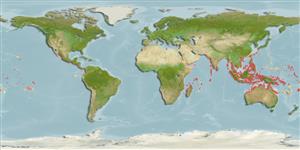Common names from other countries
>
Anguilliformes (Eels and morays) >
Muraenidae (Moray eels) > Muraeninae
Etymology: Strophidon: Greek, strophos = twisted + Greek, odous = teeth (Ref. 45335).
More on author: Hamilton.
Environment: milieu / climate zone / depth range / distribution range
นิเวศวิทยา
เกี่ยวกับทะเล,น้ำเค็ม; น้ำจืด; กร่อย เกี่ยวกับหินโสโครก; dH range: 15 - 30; สัตว์น้ำที่อพยพไปๆมาๆ ระหว่างแหล่งน้ำจืดกับทะเล ที่เป็นไปตามช่วงชีวิต (Ref. 51243); ระดับความลึก 0 - 15 m (Ref. 1602). Tropical; 23°C - 28°C (Ref. 13614); 30°N - 23°S
Indo-West Pacific: Red Sea and East Africa to the western Pacific.
ขนาด / น้ำหนัก / Age
Maturity: Lm ? range ? - ? cm
Max length : 400 cm TL เพศผู้/กระเทย; (Ref. 3258); common length : 70.0 cm TL เพศผู้/กระเทย; (Ref. 3258)
สัตว์มีกระดูกสันหลัง: 183 - 196. Brownish grey above, lighter below (Ref. 3257). Body moderately elongate, cylindrical in front, compressed along tail; eyes small; teeth small, biserial, inner series enlarged; head not obviously distinct from trunk although the profile is moderately steep; very large mouth, extending to well beyond eye; biserial sharp teeth on jaws, larger in front and in inner row; dorsal fin inserted on head before gill-opening; scales absent (Ref. 4832).
Inhabits muddy ocean bottoms (Ref. 6934) and estuarine areas (Ref. 2334), but sometimes found in rivers (Ref. 2334) and inner bays (Ref. 37816). Feeds mainly on a variety of small fishes and crustaceans. Known to extend itself vertically from a burrow with its head held horizontally beneath the surface, rising and falling with the tide (Ref. 9710). Marketed fresh and consumed locally (Ref. 3258). Solitary (Ref 90102).
Life cycle and mating behavior
Maturities | การสืบพันธุ์ | Spawnings | Egg(s) | Fecundities | ตัวอ่อน
Chen, H.-M., K.-T. Shao and C.T. Chen, 1994. A review of the muraenid eels (Family Muraenidae) from Taiwan with descriptions of twelve new records. Zool. Stud. 33(1):44-64. (Ref. 6934)
IUCN Red List Status (Ref. 130435)
CITES (Ref. 128078)
Not Evaluated
Human uses
การประมง: มีการค้าเพียงเล็กน้อย; การตกปลาเป็นกีฬา: ใช่
เครื่องมือ
Special reports
Download XML
แหล่งที่มาจากอินเตอร์เน็ต
Estimates based on models
Preferred temperature (Ref.
115969): 25.5 - 29.3, mean 28.5 (based on 3263 cells).
Phylogenetic diversity index (Ref.
82804): PD
50 = 1.0000 [Uniqueness, from 0.5 = low to 2.0 = high].
Bayesian length-weight: a=0.00023 (0.00015 - 0.00034), b=3.13 (3.02 - 3.24), in cm Total Length, based on LWR estimates for this species & (Sub)family-body (Ref.
93245).
ระดับชั้นอาหาร (Ref.
69278): 3.4 ±0.46 se; based on food items.
ความสามารถในการกลับคืนสู่ปกติ (Ref.
120179): ต่ำ, เวลาต่ำสุดที่จะทำให้ประชากรเพิ่มขึ้นเป็น 2 เท่าใช้เวลา 4.5 - 14 ปี (K=0.01).
Fishing Vulnerability (Ref.
59153): Very high vulnerability (90 of 100).
